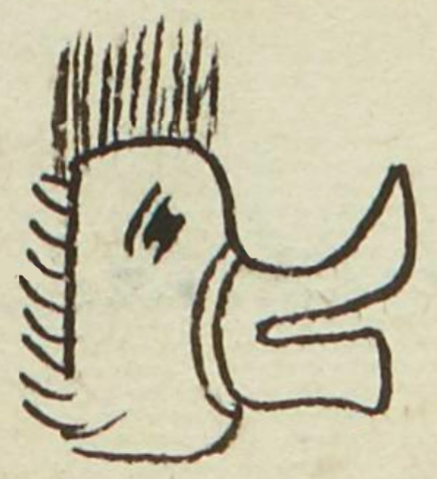Chiucnauhecatl (MH712v)
This simplex glyph for the personal name, Chiucnauhecatl (or Chiucnahui Ehecatl), “Nine-Wind”, is attested here as a man’s name. This is a calendrical name, taken from the 260-day divinatory calendar called the tonalpohualli. It features the head of the divine force of the wind (ehecatl), shown in profile, facing toward the viewer’s right. The hair on this head is standing upright at the top, something in the manner of a monkey (ozomatli). Short horizontal lines as the back of the head account for the number 9 (chiucnauh-). The head wears a buccal mask, something like a duck bill. This mask was perceived to be for blowing wind around.
Stephanie Wood
As is often the case, the gloss here uses ecatl (which can mean air or breath) instead of ehecatl (wind). But the combination of the day sign, ehecatl, with a number (here, nine) makes it clear that this is a calendrical name and references the divine force of wind. Ehecatl has an association with monkeys, as is explained in this Mesoweb example.
Stephanie Wood
1560
Jeff Haskett-Wood
viento, nueve, números, aliento, aire, deidades, fuerzas divinas, fuerzas sagradas, monos, nombres de hombres, calendarios, nombres de días

chiucnahui, nine, https://nahuatl.wired-humanities.org/content/chiucnahui
eca(tl), air, breath, https://nahuatl.wired-humanities.org/content/ecatl
eheca(tl), wind or divine force of wind, https://nahuatl.wired-humanities.org/content/ehecatl
Nueve Viento, o 9-Viento
Stephanie Wood
Matrícula de Huexotzinco, folio 712v, World Digital Library, https://www.loc.gov/resource/gdcwdl.wdl_15282/?sp=503&st=image
This manuscript is hosted by the Library of Congress and the World Digital Library; used here with the Creative Commons, “Attribution-NonCommercial-ShareAlike 3.0 License” (CC-BY-NC-SAq 3.0).



